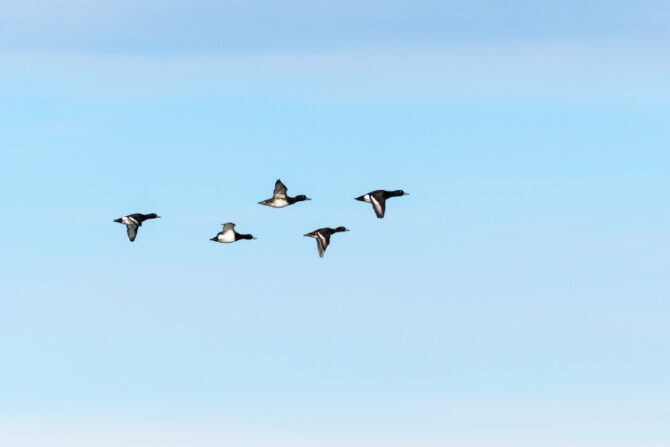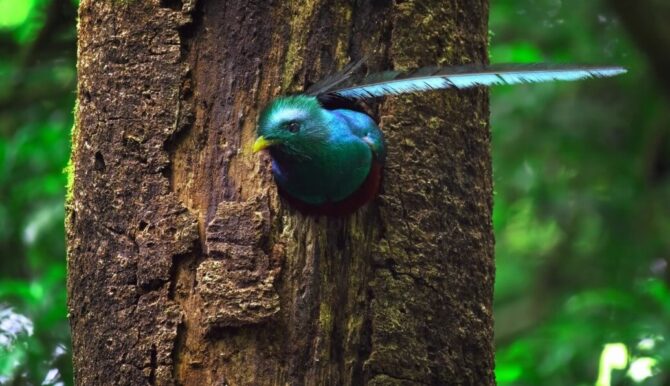Birds are amazing creatures, which explains why they have numerous fans. There are a lot of qualities these animals have and behaviors they portray, some of which makes one curious.
One such behavior is that of birds flying in circles, a feat that’s both lovely to watch and a tad mysterious. But why do birds fly in circles?
Birds fly in circles for many reasons, the most common being the use of thermals. They also do this to confuse predators, save energy, search for food, or even before a storm.
In this article, we’ll delve into the different reasons birds fly in circles.
Why Do Birds Fly In Circles?

There are many reasons birds fly in circles, and we’ve rounded up some of the most common. They are:
1. Thermals
Birds are often seen flying in circles between morning and mid-afternoon, as this is when thermals occur.
Thermals are rising currents of warm air, and this is made possible by the heat.1 Thermals are common in mountainous areas but can be found in many other places.
You have possibly seen one before. It comes in different forms, one of which is the “dust devil.”
Thermals enable birds to fly with ease, and they don’t have to flap their wings.
Of course, thermals have a limited range, so if they want to enjoy floating with little effort, they have to stay within that range. This makes them stay in a circle.
2. A storm
Thermals might be the most common reason for birds flying in a circle, but it isn’t the only one.
Birds can also exhibit this behavior when faced with a change in weather.
Birds can sense this change even before humans do, and they need to remain calm as they find a safe place to stay.
Flying in a circle helps them maintain this calmness, and they also conserve their energy while seeking refuge from the storm.
3. Food
This is more common in birds of prey like eagles, hawks, pelicans, condors, gulls, and vultures.
Because they hunt from far up, they fly in a rounded pattern while looking for prey (or carrion in the case of vultures).
They make use of thermals to achieve this flight pattern, and with their sharp eyesight, they easily detect prey from afar.
Flying in a circle helps them conserve energy as they hunt. They can do this for a long period till they get the desired result, which is their next meal.
4. Survival as prey
Not all birds are predators. Some birds are prey and, as such, are targets for many other animals.
Their predators include other birds and some terrestrial creatures. To survive as prey, they have to confuse their predators, especially their fellow birds. Flying in a circle helps achieve this.
The pattern makes the predator unable to pinpoint a particular bird to attack, as there would be many of them.
It tends to leave the predator bewildered, and it may give up in the end.
5. Dancing
Humans aren’t the only ones that can dance. Many animals can, including a lot of bird species.
What prey birds do to confuse predators can be considered a form of dancing as they move in a particular pattern. But that’s not the only time birds dance.
They also bust some moves during their courtship period. This is done by males in a bid to get the females attracted to them.
The dance moves can be in different ways, one of which is turning in circles. The pigeon is a good example of a bird that courts by dancing in circles.
Another important reason birds move in circles is to navigate their environment.
Sometimes birds get lost—much like humans—and they need to find their bearing. Circling helps them find their way back.
This is usually done by migratory birds when they get off track. It is similar to how we make a detour when we’re confused about a particular location.
7. Invitation to migrate
Circling for migratory birds is not only for navigation purposes. They also use it as an invitation, calling other birds to join them as they migrate.
This isn’t done by all species, though. Examples of birds that fly in circles to invite others to migrate are vultures, hawks, and sterlings.
When they circle this way, other birds interested in migrating will join in the rhythmic movement.
8. Updraft riding

An updraft is a strong air current going towards, just as the name shows. Birds love riding an updraft, and they do this by flying in a circle.
This is usually observed amongst solitary species that either move in pairs or small groups.
The updraft helps them move to higher levels in the skies as they go from one level to the other.
This is especially beneficial for bigger birds that love to stay above ground.
9. Warmth
Winter months can be challenging for birds due to the drop in temperature. They don’t have mittens, sweaters, and other warm outfits.
Thus, they need other ways to keep warm. They achieve this in many ways, including flying in circles.
Moving this way helps their body generate warmth. They also stay close to their flock while circling to conserve heat.
10. Save energy
This particular point encompasses many of the aforementioned ones. Birds fly in circles to conserve energy, a much-needed ability for migratory birds.
The latter can fly for kilometers without stopping, so the only time they have to rest is when they circle.
They slow down and float around before continuing their journey.
What Types of Birds Fly in Circles?
Given that this is a common behavior, one might assume that all bird species exhibit this behavior.
However, that is not the case. Birds of prey are more likely to fly in circles. Examples are eagles, vultures, and hawks.
Naturally, these birds fly very high, making it easier for them to circle.
Pigeons also do, even as a form of communication. They also court by turning in circles, and some other reasons are escaping from predators and also trying to find their bearing.
Some birds, such as vultures, do so as a way to spot potential prey or to find thermals that will help them stay aloft for longer periods of time.
Other birds, such as geese and swans, fly in circles as a way to stay together as a flock and to communicate with each other.
Wrap Up
In conclusion, it is clear that there are many different reasons why birds may fly in circles.
Birds of prey are more likely to exhibit this behavior, but not to the exclusion of smaller birds.
Regardless of the specific reason, it is clear that the ability to fly in circles is an important aspect of a bird’s survival and behavior.
Understanding the various factors that influence a bird’s flight patterns can help us better appreciate the complexity and beauty of these amazing creatures.
Bird watchers will get a treat from viewing these birds circling.
Next up…
- Why Do Birds Suddenly Appear? The Answer Is More Than A Song
- Why Do Birds Fly Into Windows? (The Sad Truth & Prevention)
References & Notes
- Thermal | English meaning. Cambridge Dictionary.






